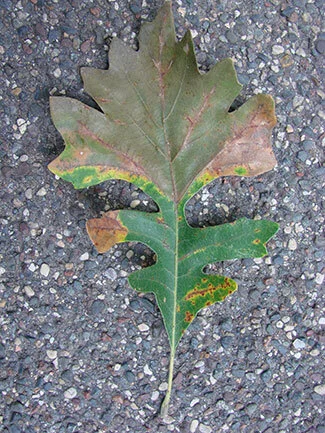Bur Oak Blight Management
Introduction to Bur Oak Blight
Bur Oak Blight (BOB) is a newer disease to our area, caused by the fungus Tubakia iowensis. This leaf blight is often mistaken for Oak Wilt, or other foliar disease. As the common name suggests, this disease is found in Bur Oak (Quercus macrocarpa), with some instances of being found on hybrids and Swamp White Oak as well.
Causes of Bur Oak Blight
Unlike other Oak species, it is not “normal” for Bur Oak trees to hold their leaves well into the winter. Infection occurs during spring, but symptoms are not noticed or apparent until mid-later July, when leaves begin to discolor and drop. The disease typically presents in the lower (inner) canopy first, spreading upwards and throughout the canopy as infection becomes more severe. Rain will present favorable conditions for secondary spread, once the disease has established itself. Bur Oak Blight tends to get worse over time, as the fungal inoculum (held by diseased leaves and petioles) remains in the canopy to reinfect the following season. Once symptoms are noticed, it is too late to treat for that season.
BOB causes stress on the tree, but is not commonly the primary cause of tree mortality. It does, however, predispose the tree to other pests and diseases such as Armallaria root rot and Two-Lined Chestnut Borer. Proper management of BOB includes addressing site factors and taking measures to improve tree health, in addition to treating the disease itself.
Signs & Symptoms of Bur Oak Blight
Bur Oak Blight foliar symptoms present with wedge-shaped necrotic areas that spread inward towards the midrib, and down to the petiole. Black “pustules” become visible on the leaf surface and along the petiole as the foliar symptoms progress. These are the fruiting bodies of the BOB fungus, and are used for field diagnosis. They are visible with the naked eye or with the aid of a 10x hand lens. The leaf symptoms intensity throughout August and into September when severely infected trees can become fully defoliated.
Bur Oak Blight Treatment Plan
We treat bur oaks for blight using the following methods:
We recommend a low volume macro-infusion with Alamo (Propiconazole 14.3%) systemic fungicide and water (at the high product rate of 20mL/inch diameter). This infusion should ideally be timed with early leaf expansion in spring. If properly timed, the fungicide will have maximum translocation to the new leaf tissue.
Treatments provide two years of suppression of foliar symptoms. For best results, we also recommend an adjunct treatment with the tree growth regulator Cambistat.
Assessing for Two-lined Chestnut Borer infestation is also essential. If detected, we strongly recommend treatment of this pest.
Long-term solutions to chronic BOB infections may additionally include addressing other site factors, such as soil compaction and/or nutrient deficiencies.


